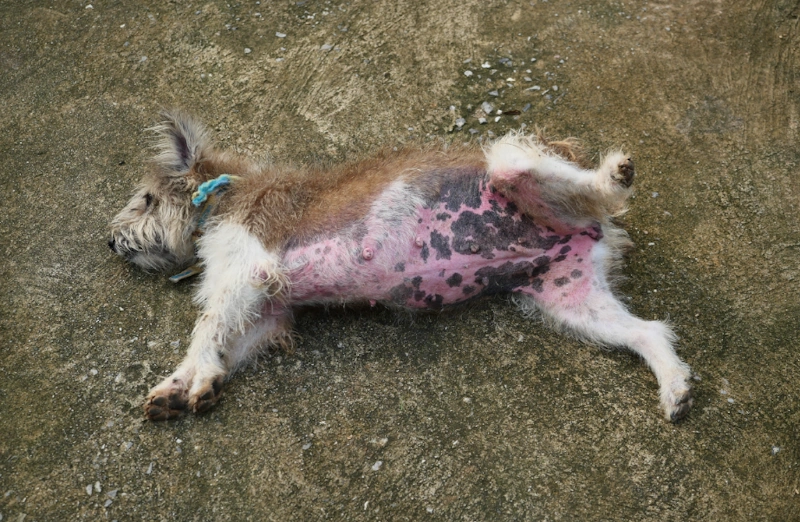Being our faithful companions, dogs share many similarities with humans, including their vulnerability to various skin issues. Among these, skin rashes are a common ailment that afflicts dogs.
Dog rash on belly can be a source of significant discomfort and concern for both pets and their devoted owners. Understanding the causes, symptoms, and available treatment options for dog rash on belly, it is crucial to ensure your four-legged friend’s well-being, happiness, and overall health.
Like in humans, skin rashes in dogs can result from many factors. These rashes can be a mere annoyance or, in some cases, indicative of underlying health concerns. Recognizing the common causes, understanding the symptoms, and knowing the available treatments are essential to responsible pet ownership.
Common Causes of Dog Rash
Allergies: Allergies are a leading cause of dog rash on belly. These can be triggered by food, environmental factors (such as pollen or dust mites), or contact with irritants like certain shampoos or cleaning products.
Parasites: External parasites like fleas, ticks, mites, and lice can lead to skin irritation and rashes. These tiny pests can cause intense itching and discomfort for your dog.
Infections: Bacterial and fungal infections can result in dog rash on belly. Common skin infections include pyoderma (bacterial) and dermatophytosis (fungal).
Environmental Factors: Environmental factors like extreme weather conditions, exposure to toxic plants, and even sunburn can cause skin irritation and dog rash on belly.
Contact Dermatitis: Dogs can develop contact dermatitis from contact with allergenic or irritating substances like certain plants, chemicals, or fabrics.
Autoimmune Disorders: Autoimmune conditions, such as pemphigus or lupus, can manifest as dog rash on belly. These disorders occur when the immune system mistakenly targets the body’s tissues.
Hormonal Imbalances: Hormonal imbalances, particularly thyroid and adrenal issues, can lead to skin problems and rashes in dogs.
Symptoms of Dog Rash
Recognizing the symptoms of dog rash on belly is paramount for prompt intervention and ensuring your furry friend’s well-being. Dog rashes can manifest in various ways, signifying a different skin condition aspect. The common signs and symptoms include:
Redness is one of the earliest and most noticeable signs of dog rash on belly. The affected area typically takes on a vivid, reddish hue, which indicates inflammation and irritation of the skin. The redness clearly indicates something is amiss, prompting owners to investigate further.
Itching: Dogs experiencing rashes often exhibit intense itching, manifesting as scratching, licking, or chewing the affected area. The constant scratching or licking alleviates discomfort, but it can exacerbate the condition and, in some cases, lead to secondary infections.
Swelling: Inflamed tissue can result in swelling in the rash area. This swelling makes the affected area more noticeable and adds to the dog’s discomfort. Swelling is often a secondary response to the underlying issue, and addressing it is crucial for relieving the dog’s discomfort.
Pustules or Blisters: In more severe cases, mainly when the rash is caused by infection or allergic reactions, bumps or blisters may develop as a result of dog rash on belly. These raised, fluid-filled sacs can be filled with pus or clear fluid. They indicate that the skin has become compromised, and prompt treatment is necessary to prevent the rash from worsening.
Hair Loss: Dog rash on belly and other parts of the body can lead to hair loss in the affected area. As a dog scratches and gnaws at the rash, the hair follicles can become damaged, and hair may fall out. Hair loss is an aesthetic concern and exposes the skin, making it more vulnerable to further irritation and potential infections.
Scabs and Crusts: Due to the dog’s constant scratching and gnawing at the rash, scabs and crusts may form as a result of dog rash on belly. These scabs are the body’s natural response to healing and serve as protective barriers over the damaged area. While scabs are a sign that the body is trying to heal, they can also be itchy and uncomfortable for the dog.
Hot Spots (Acute Moist Dermatitis): Hot spots, also known as acute moist dermatitis, are particularly problematic manifestations of a dog rash. These are inflamed, painful areas of the skin that can develop rapidly if not treated promptly. Dog rash on belly with hot spots are often seen licking or biting at the area incessantly. Hot spots require immediate attention to prevent them from worsening and causing further distress to the dog.
Understanding these various symptoms of dog rashes is essential for owners to provide timely care and alleviate their pet’s discomfort. If you observe any of these signs, including dog rash on belly, it is advisable to seek professional veterinary guidance to properly diagnose the underlying cause and implement the most effective treatment plan.
Treatment Options for Dog Rash
The treatment of a dog rash depends on its underlying cause, severity, and location. Here are some standard treatment options:
Identifying and Removing the Cause: If the rash is caused by an allergen, parasite, or irritant, the first step is identifying and eliminating the source. This may involve dietary changes, adjusting environmental factors, or using flea and tick control products.
Topical Medications: For mild rashes, veterinarians may recommend topical ointments, creams, or shampoos containing soothing ingredients like aloe vera or hydrocortisone to alleviate symptoms and promote healing.
Oral Medications: In more severe cases, your vet may prescribe oral medications, such as antibiotics, antifungals, or corticosteroids, to address the underlying issue and control inflammation.
Medicated Baths: Medicated baths with specialized shampoos can help treat skin conditions and relieve itching and irritation.
Dietary Changes: If allergies are the culprit, a hypoallergenic or elimination diet may be recommended to identify and eliminate the trigger.
Antihistamines: Antihistamines can alleviate itching and inflammation caused by allergies.
Immune System Modifiers: In cases of autoimmune disorders, immune system modifiers like cyclosporine or prednisone may be prescribed to suppress the immune response.
Supportive Care: Proper nutrition, hydration, and grooming can aid overall recovery. Additionally, using protective collars (e-collars) can prevent your dog from exacerbating the rash by excessive scratching.
Preventative Measures: Regular grooming, cleaning your dog’s living environment, and providing parasite control can prevent future rashes.
Key Takeaways
Dog rashes can be frustrating and uncomfortable for both dogs and their owners. Understanding the common causes, symptoms, and treatment options is essential for managing these skin problems effectively. If your dog displays signs of a rash, it is advisable to consult a veterinarian who can diagnose adequately and recommend the most suitable treatment plan. With the proper care and attention, you can help your furry companion recover from a rash and enjoy a healthy, rash-free life.
Does your dog show symptoms of rashes? Call the Sunshine Pet Hospital today for immediate veterinary care and a professional, gentle hand in helping remedy your dog’s medical needs.


